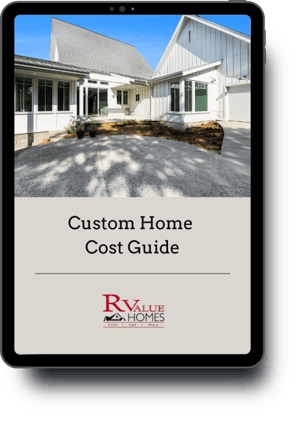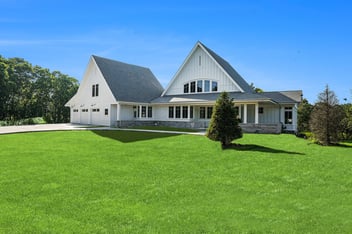6 Min Read
The WORST Wall System For Your Lake Michigan Custom Home (it’s not what you think!)
You can’t unknow something. If you are happy with the status quo, maybe it’s best to skip this post and move on. If you read this, you may end up like me: convinced it is unethical to build a home you know will have hidden problems.
You’re thinking of building a custom home in West Michigan, maybe a lakeshore home where the winds can blow pretty hard. So you do your research and ask around: friends who have built recently, home designers, lumberyards, maybe even a builder or two.
You want to strike the right balance between cost to build, energy efficiency, and environmental responsibility. But if you’ve spoken with 10 people, you have probably heard 10 different ways; all claiming to be the best: 2x6 walls, open cell or closed cell spray foam, double stud walls, T-Studs, exterior insulation, SIPs, ICFs, and the options go on and on.
%20blog.png?width=651&height=366&name=The%20WORST%20Wall%20System%20For%20Your%20Lake%20Michigan%20Custom%20Home%20(it%E2%80%99s%20not%20what%20you%20think!)%20blog.png)
But Which Is The Best?
The answer to that question is not simple. It is highly dependent on many factors, such as which climate zone the home will be located in, but also the occupancy, size, soil conditions, specific needs of the client, overall objective, availability of experienced and skilled tradesmen, etc.
Determining the best exterior wall system for you will consider all of the above factors, and probably more. I believe the best person to guide you through that decision is a builder committed to continuous education, one who puts your needs ahead of his own.
The Worst Wall for Michigan Homes
It is far easier to explain what the worst wall is. This answer is unique to homes in Climate Zone 5 and 6, which are both zones found in Michigan, where I have experience building energy efficient and net-zero homes. Nevertheless the worst wall is just plain bad, no matter how many people will be in the home, whether it is a vacation or full-time dwelling, whether occupants have environmental allergies or not, and whether there are craftsmen available to do the work.
Without hesitation the worst exterior wall is a 2x6 wall with 1” of exterior foam and batt insulation. Note that most people would say this wall has an r-value between 26 and 28; well above the current energy code minimum! 1” of XPS exterior insulation has an r-value of 5, while 5.5” batt insulation is available as either r-19 or r-21. R-5 plus r-21 equals r-26, right? Wrong, but we’ve been here before.
So....what makes it so bad?
The main reason is moisture. Moisture in 2 states: liquid and vapor.
For our purposes today, let’s pretend that we have built such a perfect wall that liquid water from our Michigan storms never makes it into the wall. We will only talk about vapor, also known as humidity.
Once again, we will set aside any consideration of humidity from outside the home, and only consider the effects of interior humidity on the wall system. This will highlight the big reason that this particular wall system, the darling of so-called energy efficient builders, is a poor idea.
This Is An Upgrade From Tents And Cave Dwelling!
Interior humidity comes mainly from exhaling, showering, cooking, pets, and plants. A law of physics is that high concentrations of vapor are driven to areas of low concentration. That vapor is always going to the coolest locations possible.
In our heating dominated climate, vapor drive is most often from inside the home to outside. (Humidity will also concentrate in basements, creating damp and musty spaces; but that is a problem for another day.) So in an old home with little insulation, this vapor was carried to the outside through leaky walls and dissipated into the Michigan winter. No problems so far, as long as you don’t mind the super dry air resulting in itchy skin, static electricity, bloody noses, increased susceptibility to viruses, and waking up with a dry mouth in the middle of the night. But hey, we didn’t know any better. We just put mason jars of water on the woodstove, or ran the humidifier and dealt with it.

How The Problem Started - Green Homes In Michigan
But then we started to learn more; just enough to be dangerous in fact.
We began tightening up the homes by wrapping them with a weather resistive barrier (WRB), also known as housewrap. This had the net effect of reducing the flow of air (and the moisture it carried) out. Where did that moisture go? It stayed in the home. In fact, the moisture condensed inside the exterior wall, on the backside of the sheeting.
At the same time we were adding insulation, which reduces the flow of heat, and thus the ability of the wall to dry. So now we had walls that got wet, and didn’t dry out very fast. If you’re thinking that doesn’t seem good, you are doing better than a lot of builders.
If a wall gets wet then promplty freezes, no problem. Even if the sun shines on that wall and heats it up so that it melts, but it quickly freezes again, this is probably ok. The problems come in when the wall stays wet and warm for some time, causing decay and/or mold growth. Now we have a durability problem, with the distinct possibility of additional air quality and health problems.
A Solution That Makes The Problem Worse--Follow Me Closely Here
Once again, some smart people solved the problem. But too many builders don’t implement it correctly.
Since the vapor is condensing on the sheeting, why not warm that sheeting up above the dewpoint, thereby preventing condensation? By applying exterior insulation under the siding, but over the sheeting; we can prevent that outer layer of the wall from ever getting cold enough for the humidity to form droplets of water, like we see on a cold glass of iced tea on a humid day.
So far, so good.
But in reality, many builders only exaggerated the problem. They didn’t use enough exterior insulation.
You see, when exterior insulation is added, there is EVEN LESS ability for air, heat, and vapor to move through the wall. Turns out XPS is pretty good at stopping vapor movement. But that means even more vapor is present to form condensation. The wall is even worse at drying. Most builders don’t add enough exterior insulation to truly prevent condensation.
1” insulation is simple enough to nail through to hang the siding. Some guys will even nail through 1.5” insulation, but that gets difficult. Builders concerned about quality are not going to nail through 2” exterior insulation--they will instead add furring over the insulation, followed by the siding. But that gets time consuming and costly, so most just add 1”.
How Much Exterior Insulation Is Enough?
To calculate this we have to make some assumptions--interior temperature and humidity, exterior temperature and humidity. We need to know the type and amount of insulation in the wall cavity. What about rooms that are always wetter, like bathrooms? What about sunlight reversing vapor drive and/or melting frost in the wall? What about extreme cold events? And what happens in the summer when it is hot and humid outside, but cool and dry inside? Most of these factors are constantly changing, but our math can only calculate risk in a steady-state.
Each of these factors deserves a paragraph or more. All of these factors make calculating the right amount of exterior insulation....tricky. Help is available, such as the WUFI model.
But since you want to get to an answer, a good rule of thumb (something this important should not be left to rule of thumb, by the way) is that in climate zone 5, 1/3 (33%) of the insulation should be on the exterior of the home. That will be enough to prevent condensation under most conditions of the year, for most homeowners, and most homes.
Checking that against our r-26 wall, we find that the exterior insulation (r-5) is less than 20%. So we have a wall that will get wet sometimes, but cannot dry out. And that is why it is the worst wall system. It may take a long time for the problems to reveal themselves, but it will happen: mold and decay, leading to structural and health problems.
Case in point: About 7 years back, we were hired to improve the energy performance of a custom home built in 2007. One of the first things we did was remove the siding so that we could install exterior insulation. But the amount of rot we found in this 10 year old home surprised even me. Before we could even begin to improve the insulation, we had a bunch of sheeting to replace! Did I mention that sheathing is key to the structure of your home?
A Close Second
An honorable mention is the double stud wall, which is still technically breathable (allowing the movement of vapor) but is so highly insulated that often the insulation ends up getting wet along with the sheathing. The dewpoint still happens inside the wall cavity, and the extreme thickness of the insulation limits its ability to dry out.
A popular wall just a decade ago, although no longer allowed by code performs better in this respect. The humble 2x4 wall with batt insulation. This wall did not trap nearly the moisture of many of the walls today. Codes are catching up, but most builders are simply unaware (Studying a 600+ page code book that updates every few years is not on most people’s “fun to do” list, and that includes the code enforcement officials).
Is Jake Just Making The Case For ICF?
It is true, Insulated Concrete Form (ICF) walls are an excellent method of preventing these problems, though there are others. Building scientists and innovative builders have devised various approaches, such as sealing off vapor at the inside of the wall, or applying breathable exterior insulation. Most of these are either complicated or make a compromise somewhere; choosing to optimize for either summer or winter conditions.
I like the elegant simplicity that ICF walls bring to the table, not to mention the fact that ICF walls are optimized for every single climate zone out there. But ICF is not the only way, check out The Perfect Wall for another example.
Wondering Which Is Right For You? We Have The Experience To Guide You.
Ready to build a high-efficiency custom home in West Michigan? We’re ready to help you figure out the best way forward. Connect with us today.





